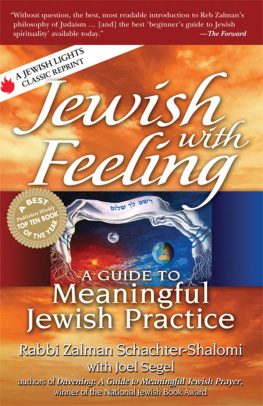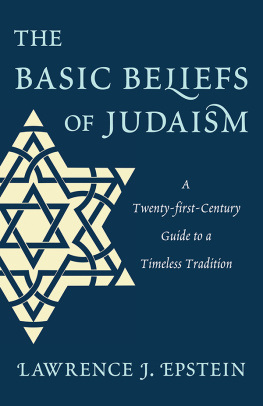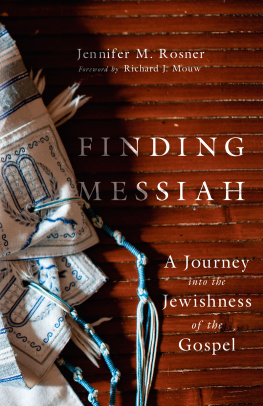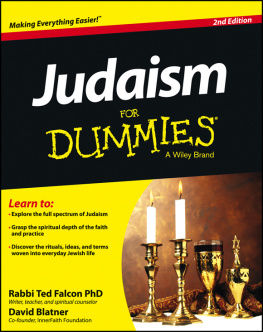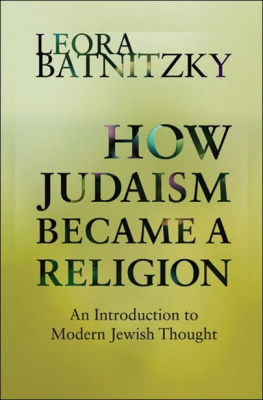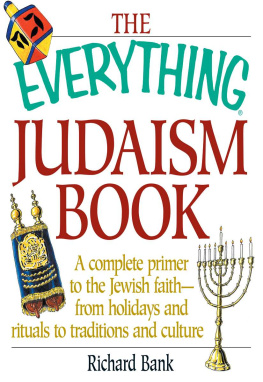Understanding
Judaism
Understanding
Judaism
The Basics of
Deed and Creed
Rabbi Benjamin Blech

First Jason Aronson Inc. softcover edition1992
This book was set in 11/13 Times Roman by Simcha Graphic Associates of Brooklyn, New York, and printed and bound by Book-mart Press of North Bergen, New Jersey.
Copyright 1991 by Benjamin Blech
11 12 13 14 15 16 17 18 19
All rights reserved. No part of this book may be used or reproduced in any manner whatsoever without written permission from Jason Aronson Inc. except in the case of brief quotations in reviews for inclusion in a magazine, newspaper, or broadcast.
Library of Congress Cataloging-in-Publication Data
Blech, Benjamin.
Understanding Judaism : the basics of deed and creed / Benjamin Blech.
p. cm.
Includes bibliographical references and index.
ISBN: 978-0-87668-291-3
1. Commandments (Judaism). 2. JudaismDoctrines.
3. JudaismEssence, genius, nature. I. Title.
BM520.7.B58 1991
296dc20
90-24947
Printed in the United States of America on acid-free paper. For information and catalog write to Jason Aronson Inc., 230 Livingston Street, Northvale, New Jersey 07647-1726. Or visit our website: www.aronson.com
The wine belongs to the owner
and thanks are given to the butlerBaba Kamma 92b
To dedicate is to acknowledge debt.
Who made this book possible?
Those who came before...
I am a tenth-generation Rabbi.
My father, Rabbi Benzion Blech, of blessed memory,
showed me the beauty of a life of saintliness and scholarship.
My mother, Gertrude, continues to inspire me in her maternal role
as the proverbial woman of valor.
Those who now share the days of my life...
My wife, Elaine, has given me more than her love;
her greatest gift has been the sustaining confidence and support
that allowed me to believe in myself
and to bring this work to fruition.
My childrenTamar and Steven, Yael and Stephen, Jordana and
Aryeh, and Arigave me the encouragement to write
and, more significantly, the contentment of a father who knows
he is blessed with the finest children on earth, as well as the
greatest grandchildrenAvital, Eitan, Talia, and Yair.
Those who today are the seeds of our future...
It is my students who helped form the thoughts,
style, and content of these pages.
To them go the thanks of a grateful teacher who has learned most
from his disciples.
And a final note of appreciation
to those very special individualsDaniel Federbush,
Yitz Grossman, Herb Mehl, and Joel Rebibo
who, each in his own way, helped turn the ideas for this book
into reality.

Contents

Preface
Llie Wiesel, universally recognized as the scribe of the Holocaust, summarized our contemporary uniqueness in these words: We are the most cursed of all generations and we are the most blessed of all generations. We are the generation of Job, but we are also the generation of Jerusalem.
Historians may well take note of the attempted genocide of our people and the subsequent return to our biblically promised homeland as the two major events of religious significance in the twentieth century. Yet there is another reality of Jewish life, asserting itself in the aftermath of the Holocaust and the birth of Israel, which could prove to have even greater meaning. The unspeakable murder of six million innocents who perished just because they were Jews led the survivors to seek a better understanding of their tradition and heritage, which had almost become obliterated. The ultimate irony of the post-Nazi era is that the Final Solution has in fact been followed by a religious revival, a movement of baalei teshuvahreligious returnees to our faithnever before witnessed in all of Jewish history, both with regard to intensity as well as numbers.
God did not die in Auschwitz. What was made clear to Moses by way of metaphor at his first encounter with the Almighty became miraculously manifest as we contemplated the failure of Hitler, the modern-day Haman, who sought total destruction of our people. Why did God initially appear to the man selected for leadership in a bush burning with fire, and the bush was not consumed? Clearly, it was not meant to demonstrate that God could perform a miracle. Any one of an infinite number of amazing conjurers feats could have been chosen. But the senehthe Hebrew word for bush, and the site later designated as Sinai, where the Torah was givenwas a plant whose indestructibility would serve as paradigm for the unique power of the Jewish people throughout history. Against all laws of nature, running counter to the principles of history as codified by Toynbee as well as the example of every other nation before or since, Jews were offered to the fires of crematoria and the torches of timeless enemies and yet were not consumed. Our people and our faith defied all logic to illustrate the miracle of survival; Israel and the message of Sinai share with the seneh the remarkable gift of indestructibility.
Contemporary survivors might have been forgiven if their theological response to the loss of close to two-thirds of our people was rejection of the God of their fathers. Indeed, some chose the road of religious denial. Yet, many others viewed irrational events as a spiritual challenge. Perhaps it was not so much God in the heavens who failed His children, but human beings below who proved how barbaric their behavior was when guided solely by secular standards and values. Even as men, women, and children were turned into bars of soap, and a self-proclaimed master race embodied a demonic cruelty, a hunger arose in the hearts of those who learned of these deeds to comprehend the life purpose of the human species, created in the image of God.
The Germans left us with questionssix million at the minimum. It became the supreme task of the post-Holocaust generation to seek and to probe, to ask and reflect, to try to comprehend a faith that had stood the test of time, but seemed to fail the confrontation with reason and a continued belief in a God both omnipotent and beneficent.
Thousands of years ago in the first Holocaust in Jewish history, which took place in Egypt, the battle cry was Let my people go. In our own time, the aftermath of a period of incomprehensibility, Rabbi Adin Steinsaltz gave birth to a new slogan: Let my people know.
Knowledge is more than power. As Solomon wrote in the Book of Proverbs: If you lack knowledge, what do you have? If you have knowledge, what do you lack? Survivors had to understand the purpose of their survival. And the answer would have to be more than trite reference to tradition or a fiddler on the roof. Let my people knowand tens of thousands of Jews searched for answers in synagogues, adult education courses, Jewish studies programs, chavurah study groups, and in the hundreds of new schools that sprung up to provide sustenance for the spiritual seekers of our generation.
Where did all these baalei teshuvah come from? Mystics suggested a fascinating response. Six million of our people had perished. Among them were approximately two million childreninfants, youngsters, and teenagersprevented from fulfilling their life potential. Was it possible that God allowed these souls a second chance, that in fact the magnitude of the baal teshuvah movement reflects the multitude of these reincarnated souls scattered throughout the world? Perhaps an outrageous suggestion, but no more farfetched than any other to explain the preponderance as well as the passion of these returnees whose existence and religious conviction cannot be accounted for in any rational manner.
Next page



